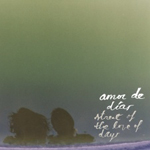|
|
 |
Dusted Reviews
Artist: Amor de Dias Album: Street of the Love of Days Label: Merge Review date: May. 18, 2011 |

|
|
|
 |
It’s not terribly difficult to image Alasdair MacLean of The Clientele recording a bossa nova album. He’s got the right whispery voice, a knack for gentle barely-there melodies, and the melancholy listlessness necessary to pull it off. Street of the Love of Days, the first album by Amor de Dias (a duo comprised of MacLean and Lupe Nuñez-Fernández of Pipas), isn’t quite that, but it’s about as close as we’re likely to get. Granted, MacLean and Nuñez-Fernández only switch into full-fledged bossa nova mode on “I See Your Face,” but the sad/sunny mood persists throughout.
Aside from “I See Your Face,” there are few surprises from MacLean here. He turns in a number of strong tracks that are more or less undistinguishable, aside from the exclusively acoustic instrumentation, from his work with The Clientele (“House of Flint,” the title track). Nuñez-Fernández’s tracks complement MacLean’s well, as both favor the same sort of gentle, understated melodies and slow tempos. The instrumentation and arrangements are rich and precise throughout, with ample doses of strings, harp and horns. While the album’s instrumental sumptuousness undeniably contributes to its appeal, it occasionally feels like a bit too much, as though overpowering MacLean and Nuñez-Fernández’s whispery voices.
The highlights of the album, “Harvest Time” and “Dream (Dead Hands),” fall precisely at its center. The former track, recorded by The Clientele on Bonfires on the Heath, finds MacLean at his dreamiest, deploying an array of wooden pipes (think “The Wicker Man”) on a beautiful all-acoustic arrangement featuring both on vocals. The latter, by Nuñez-Fernández, is a simple and repetitive harp-driven lullaby that slowly layers on multiple vocals lines from each singer. Taken together, the two tracks demonstrate that these two have found perfect collaborators in each other, and that at their best, their talents are mutually reinforcing.
Street of the Love of Days was recorded gradually over the course of three years, and it shows. As strong as many of the tracks are, Amor de Dias don’t necessarily seem to have a strong sense of what they’re after or a strong identity as a group. MacLean makes little effort to work any differently than he does with The Clientele, and the album’s 15 tracks, despite an overarching tone, come across more as a collection of one-offs than as a cohesive album. As a result, the album makes for a bit of an uneven listening experience, a problem exacerbated by the string of short fragments that pad out its second half (“Birds,” “Wandering”). Ultimately, this is only a minor setback: Nuñez-Fernández and MacLean clearly work well together, and their collaboration has offered the latter an outlet from his sometime monotonous output with The Clientele.
By Michael Cramer
|







